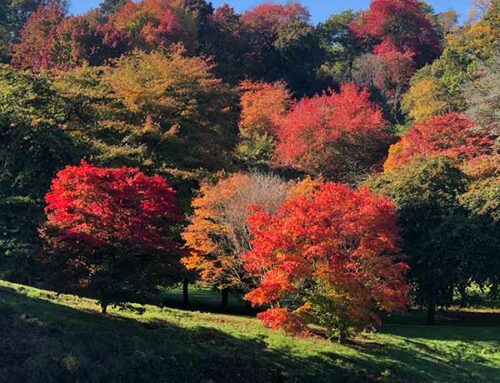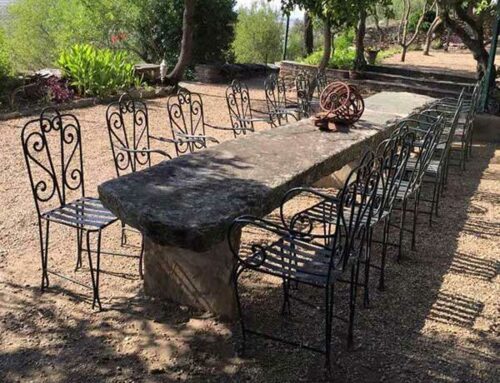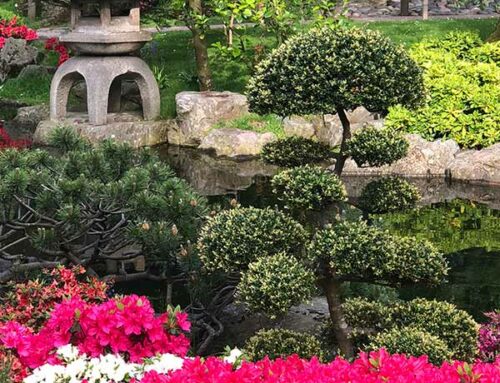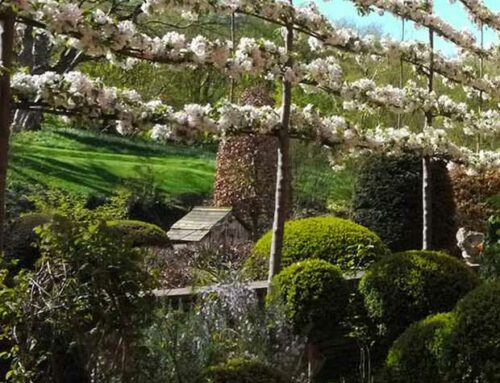Charleston House and Gardens are located near the pretty town of Lewes, in the heart of the Sussex countryside. It opened to the public in 1986 under the care of the Charleston Trust after Duncan Grant’s death in 1978.
Charleston is well-known as a place the Bloomsbury Group, a group of radical, avant-garde thinkers, gathered but it was the painters Vanessa Bell and Duncan Grant that transformed the old farmhouse and garden into an art-filled inspiration.
Bell and Grant moved to Charleston farmhouse in 1916 during the height of WW1. They were conscientious objectors and Grant needed to find farm work in order to avoid conscription.
After moving in, they painted the farmhouse’s surfaces with their own original frescoes and created a garden that would inspire painters, writers, and artists of the day. Lytton Strachey, Maynard Keynes, EM Forster, Roger Fry, Saxon Sydney-Turner, and Vanessa’s sister Virginia Woolfe all stayed at Charleston.
A studio space was added in 1925 and Vanessa’s husband Clive Bell moved in during 1939 which prompted further decoration.
The house and gardens are living history and stunning works of art. They are well worth a visit.
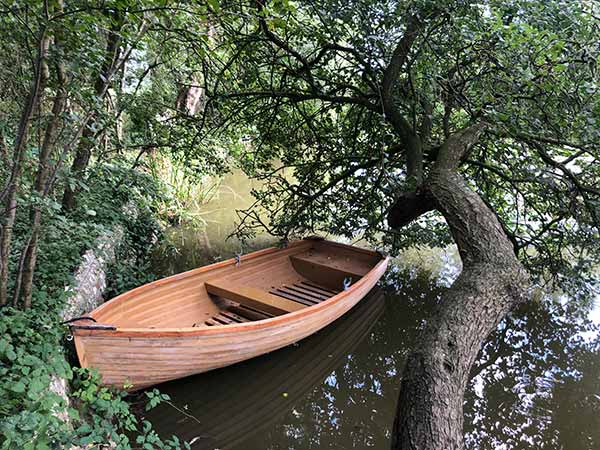
The Charming Carp Pond at Charleston
A Small But Perfectly Formed Garden
The gardens are not huge, but they are designed as a source of inspiration to artists which means every step is filled with colour, scent, form, and movement.
When Vanessa and Duncan arrived in 1916, the garden was a typical turn-of-the-century space dedicated to growing food and filled with fruit trees and vegetables. At the end of WW1 in 1918 the gardens were redesigned by their friend (and Vanessa’s ex-lover) Roger Fry. They remain much the same today.
The façade is covered in a Wisteria that frames the property with a bench to admire (or paint) the large carp pond that’s sited at the entrance to the farmhouse.
The pond is sheltered by low-growing trees and covered in picturesque water lilies, with a rowing boat on the shore, looking for all the world as if Vanessa tied it up only yesterday.
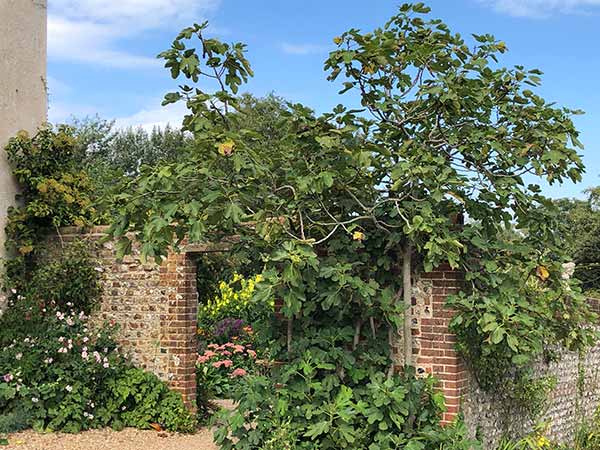
The fig tree at the walled garden entrance
The Walled Garden
The entrance to Charleston is a lovely spot, but it’s the walled garden people visit. It covers the side and rear of the farmhouse and is set into different spaces.
The small rectangular lawn used by Vanessa’s children for impromptu plays is kept short and tidy with an oblong tiled pond at the far end.
The garden borders mix bright country cottage textures such as roses, apple trees, climbing roses, and summer flowering perennials with Mediterranean influences.
In 1920 the gravel paths were installed and the beds filled with box, sea holly, and the silver foliaged plants that appear in many of Vanessa and Duncan’s paintings.
These plants are alive with colour, still attracting the bees and butterflies that Vanessa often wrote to her friends and daughter about – ‘irises have rushed out and the tulips and wallflowers are ablaze.’
Lining the walls and in the centre of flower beds, there are old gnarled apples and fig trees that make the most of the heat retaining brick walls. It’s a mass of glorious colour that’s set out in a way you can admire from all angles.
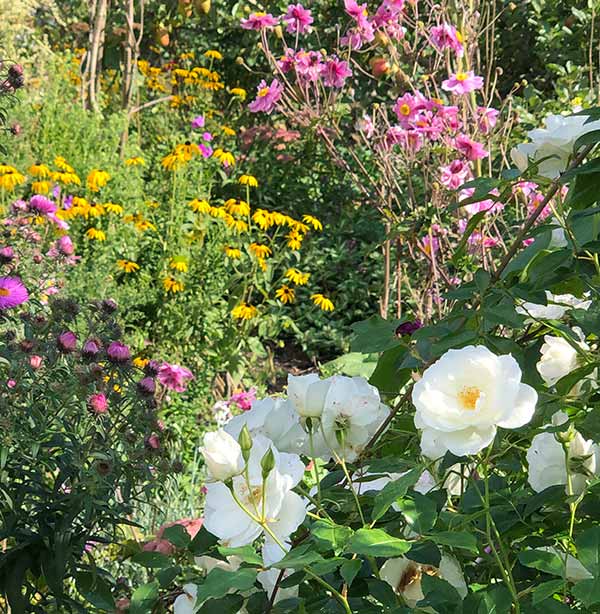
Get Inspiration for your garden from Charleston’s colourful flower borders.
Sculpture
Vanessa’s son Quentin Bell, was a talented sculptor and his art is strewn through the gardens popping up in places you wouldn’t expect it. In the pond for example and atop garden walls.
If you tour the house, be sure to look from the spare room window for the succulent Vanessa’s son Julian Bell planted on the coal shed before he left for China and was killed at the age of 29 in the Spanish Civil War.
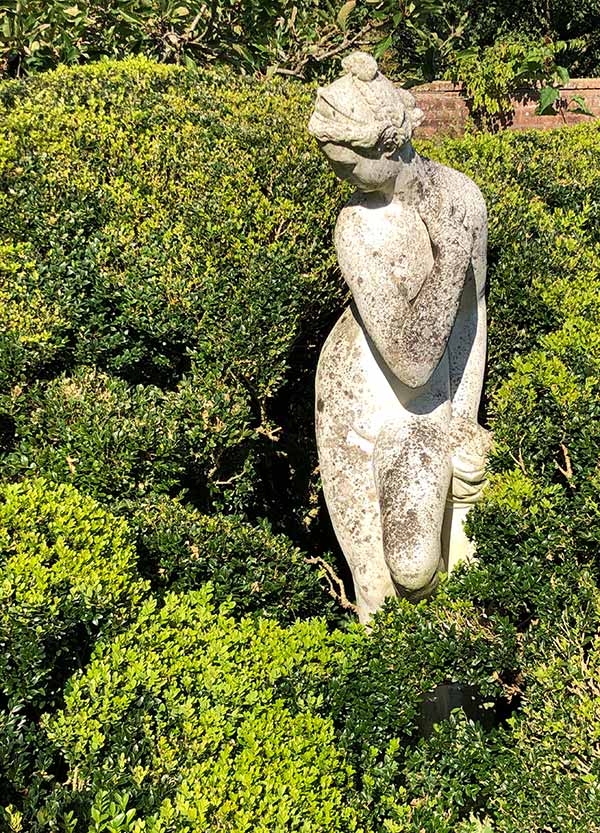
Sculpture nestled among the Buxus
Recent Improvements
The studio border, visible from Vanessa’s art studio, was recently improved by the gardener Harry Hoblyn.
Taking inspiration from Vanessa and Duncan’s border paintings Hoblyn planted Bloomsbury-era sea holly, honesty, sweet rocket, monkshood, and a whole lot of bulbs to create a ‘light, bright and transparent border.
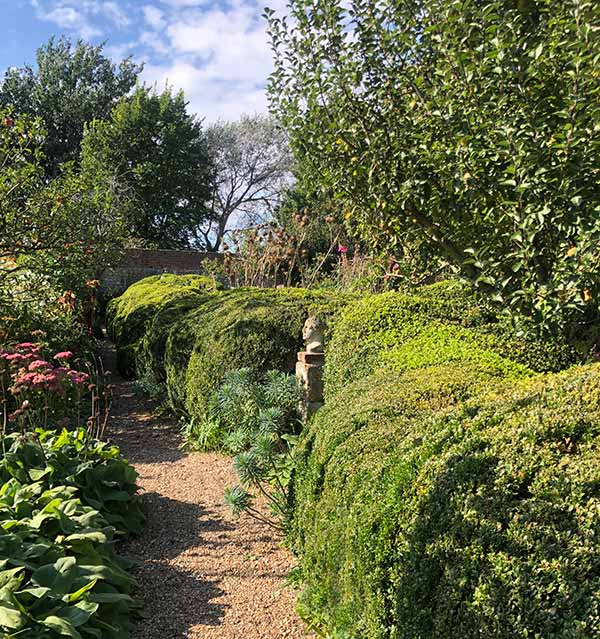
Apple Trees dispersed among the Box hedge at Charleston.
All The Essentials – Eating, Shopping and Parking!
On a dry day, Charleston gardens are perfect for a picnic. There are tables in the Centenary Garden – an area of old neighbouring farm buildings which were acquired by The Charleston Trust – and of course the grass next to the carp pond.
You can find a café and a shop in the Centenary Gardens selling focaccia and coffee, homeware, fabric, and books about the Charleston paintings.
The pathways are bound with earth, lime, and gravel, so it’s possible to visit on a wet day, but do check the access page for wheelchair access. There is parking!
Events At Charleston
There is a lively calendar of events taking place here. Recently, Vanessa Redgrave read excerpts from poems and novels, and there’s a permanent display of Duncan and Vanessa’s artwork, but for gardeners, the biggest draw is the inspirational outdoor area. It is the garden that inspired so many of their artist friends.
This is a beautiful garden and although it’s small compared to manor house gardens, admiring the planting, colours and textures can take all afternoon.
If you can spare the time make your way to Charleston Gardens. As Vanessa wrote in 1936 ‘it’s a dithering blaze of flowers and butterflies and apples.’ Who wouldn’t want to soak up that atmosphere?

